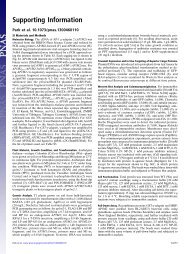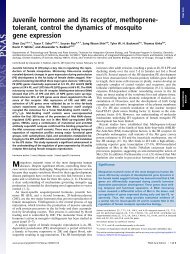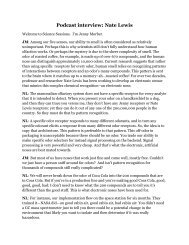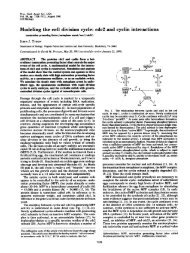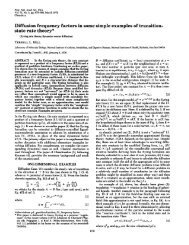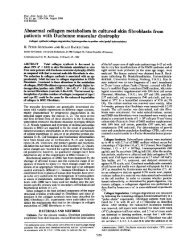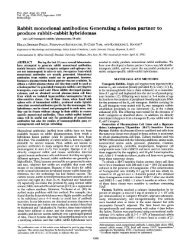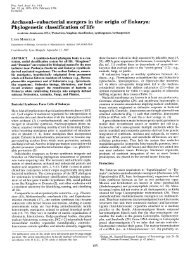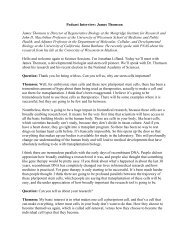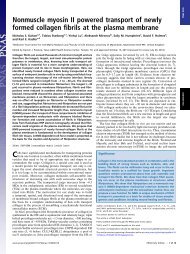Supporting Information (SI) Appendix - Proceedings of the National ...
Supporting Information (SI) Appendix - Proceedings of the National ...
Supporting Information (SI) Appendix - Proceedings of the National ...
You also want an ePaper? Increase the reach of your titles
YUMPU automatically turns print PDFs into web optimized ePapers that Google loves.
Supplementary Text<br />
Biases in grape germplasm collections: a cautionary note<br />
The conclusions from <strong>the</strong> present study are based on samples from <strong>the</strong> USDA grape germplasm<br />
collection. The USDA grape germplasm collection harbors one <strong>of</strong> <strong>the</strong> most (if not <strong>the</strong> most)<br />
extensive collection <strong>of</strong> grape genetic diversity in <strong>the</strong> world. Never<strong>the</strong>less, it is unclear to what<br />
extent this collection represents an unbiased sample <strong>of</strong> <strong>the</strong> worldwide genetic diversity <strong>of</strong><br />
vinifera. It is possible, for example, that <strong>the</strong> proportion <strong>of</strong> <strong>the</strong> morphological diversity in <strong>the</strong><br />
collection that is represented by clonal mutants is a poor representation <strong>of</strong> this proportion in<br />
vinifera worldwide. It is also possible that <strong>the</strong> extent to which vinifera cultivars are related by<br />
first degree relationships is less or more than expected from an exhaustive survey <strong>of</strong> vinifera<br />
worldwide. All germplasm collections are biased in complex and <strong>of</strong>ten unknown ways. This<br />
study is <strong>the</strong>refore an evaluation <strong>of</strong> genetic diversity in <strong>the</strong> USDA grape germplasm collection<br />
and is not an unbiased survey <strong>of</strong> worldwide genetic variation within vinifera. The reader should<br />
take this cautionary note into consideration when interpreting <strong>the</strong> results <strong>of</strong> <strong>the</strong> present study.<br />
Potential misnaming <strong>of</strong> cultivars<br />
The cultivar names associated with each DNA sample are, in some cases, clearly incorrect.<br />
There are numerous examples <strong>of</strong> such mismatches between names and <strong>the</strong>ir inferred genetic<br />
relatedness (see ftp://ftp.gramene.org/pub/vitis_2010_files/): Kyoho (DVIT 616) is actually<br />
Affenthaler; Mamelon (DVIT 586) is in fact Perle de Csaba; Gamay (DVIT 732) is likely not a<br />
true Gamay because <strong>of</strong> its inferred pedigree relationships. We have <strong>the</strong>refore not only provided<br />
<strong>the</strong> name associated with each DNA sample, but also <strong>the</strong> DVIT number, which is a unique<br />
identifier carried by each grapevine in <strong>the</strong> USDA grape germplasm collection. The naming<br />
inaccuracies may be due to curation error, sample mix-up or o<strong>the</strong>r synonym and homonym<br />
problems, which are common in germplasm collections. However, DNA sample mix-up is an<br />
unlikely explanation for most inaccuracies because sample processing was done primarily with<br />
robotics and we observed no discordance for 145 pairwise comparisons between replicate<br />
samples placed randomly across sample plates. Thus, we conclude that <strong>the</strong> cases <strong>of</strong> cultivar<br />
misidentification in <strong>the</strong> USDA grape germplasm collection are likely <strong>of</strong>ten due to curation error.<br />
We are confident that our main conclusions will not be strongly influenced by <strong>the</strong>se inaccuracies



